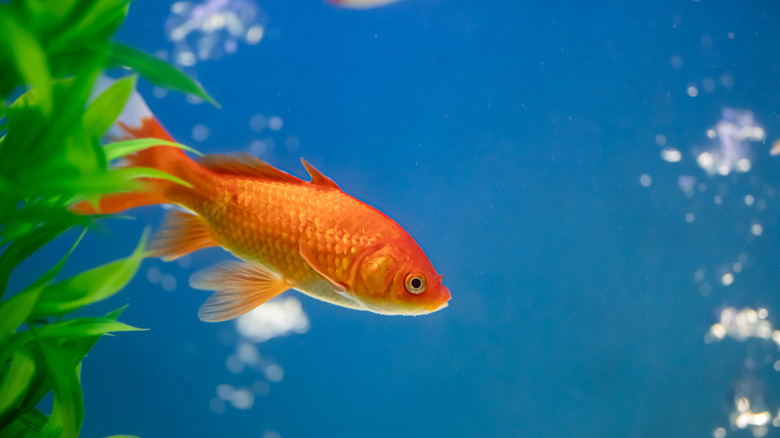What Does It Mean When A Goldfish's Top Fin Lies Down?
When a goldfish's top or dorsal fin lies down or is held close to the body, the fish is having what is called "clamped fins." This is a sign that your goldfish is stressed. Causes of clamped fins include illness, high levels of ammonia in the tank water, new tank syndrome and wrong pH levels in the tank water.
Ammonia Poisoning
If your goldfish has clamped fins and her scale color seems to lighten or she is visibly missing scales and has white patches on her body, she has been chemically burned by ammonia poisoning. Ammonia is a toxic substance that is created from goldfish waste. If the ammonia level is too high in the water, it can chemically burn the fish or in extreme cases cause death. Test your tank water's ammonia levels with a test kit that you'll find at most pet stores. If the test detects ammonia, it means the level is far too high and you will need to lower it by replacing half of the tank water: Use an aquarium siphon hose to suck out the water from the tank. Add water treated with aquarium water conditioners that can neutralize ammonia, chlorine, choramines and nitrites that is the same temperature as the tank water. Avoid ammonia poisoning in the future by changing 25 percent of the tank water every two weeks with water treated with aquarium water conditioners.
Goldfish pH Range
Goldfish prefer to live in tank water that has a pH level of 7 or 8. When the pH level leaves this range, it can cause stress on the goldfish. When the pH level is too high — when the water is too basic — it can cause chemical burns, which turn the scales white, and may cause the scales to chap or peel off. When pH levels are low the water is too acidic and low in oxygen. This may cause a goldfish to gasp for air at the water surface, turn her gills red, cause bulging or popped eyes and eye bleeding. Add limestone, baking soda or water treatments to raise the pH levels of your tank water. Add an air pump to oxygenate tank water with low pH levels.
Salt Bath
If your goldfish has been injured due to lack of oxygen, ammonia poisoning, nitrate or nitrite poisoning — and she is not bloated or does not have raised scales — you can give her a salt bath to help heal. Salt baths reduce stress on a goldfish and allow a new protective "slime" coat to grow on the body of the fish, which is a natural protective barrier. Make a goldfish salt bath by adding 1 tsp. of aquarium salt, kosher salt or sea salt per gallon of room-temperature water in a quarantine tank. Place the goldfish in the water for one to three minutes. If the goldfish appears to be stressed or lose consciousness, return her to her original tank.
